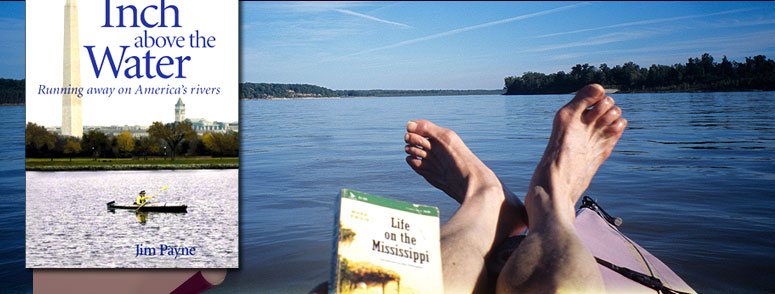Voyage on the Connecticut (page 9)
Don't think that for a kayaker such socializing excursions are without their price, however. If you drove to Windsor in a car, you would merely turn off the motor and step out. For me, getting ashore was a half-hour ordeal because of the mud that lines the Connecticut’s banks. Before disembarking I had to remove my shoes and socks and pull on rubber booties. I wrestled the boat higher on shore and tied it up, my feet all the while sinking and sucking in the mud. I forced my way up the bank through heavy vegetation—hoping to avoid poison ivy—to reach the street. There I took off the booties, wiped my muddy feet as best I could with leaves and grass, and put on my shoes and socks, leaving the booties beside the road. The operation was reversed when I returned, except that at the end I had the muddy booties to deal with. They couldn't be allowed in the boat to mess everything up, so I tied them to a line, and dragged them in the water for half a mile to wash them (they really slowed the boat!).
Several days later, I faced the challenge of getting around Holyoke Dam, in Massachusetts. I pulled ashore at the ramp of the Red Cliffe Canoe Club, wondering how I was going to contend with the mile-long portage. Two older club members were enjoying a beer up by the clubhouse and I asked them if it was okay to moor. Sure, they said, we let all kayaks and canoes use the ramp for launching and take out. I asked for advice about the portage. One man suggested calling the power company, since they sometimes give portage, and he lent me his cell phone. My call yielded a recorded message: the office was closed for the day. “Well, then,” said Alan, “I can take you around in my truck.” And so he did, helping me accomplish in five minutes what would otherwise have taken me a day.
The portage was yet another example of Samaritans at work. The Connecticut River Valley has an abundance of friendly, helpful people who assisted me at every turn—with car rides, meals, phones, directions, advice, and free mooring. One man lent me his guidebook of the river to use for the rest of the trip; another, a concert pianist, gave me a private performance of Schumann’s second piano sonata. At the start of the trip, I thought it might be interesting to count the number of people who contributed to my welfare, but the task soon proved overwhelming. If I include people who gave directions and advice, the total of Samaritans would easily pass several hundred.
~ ~ ~
Back to First Page • Next Page >

